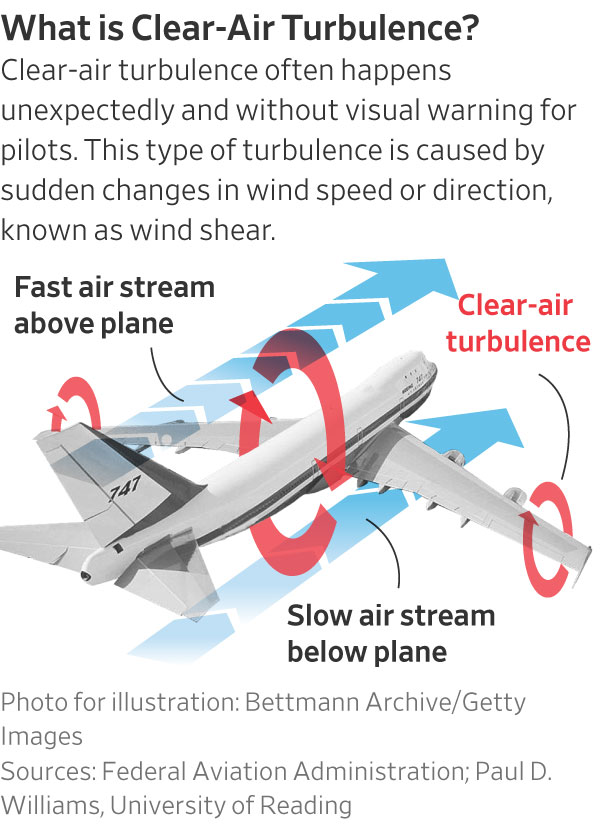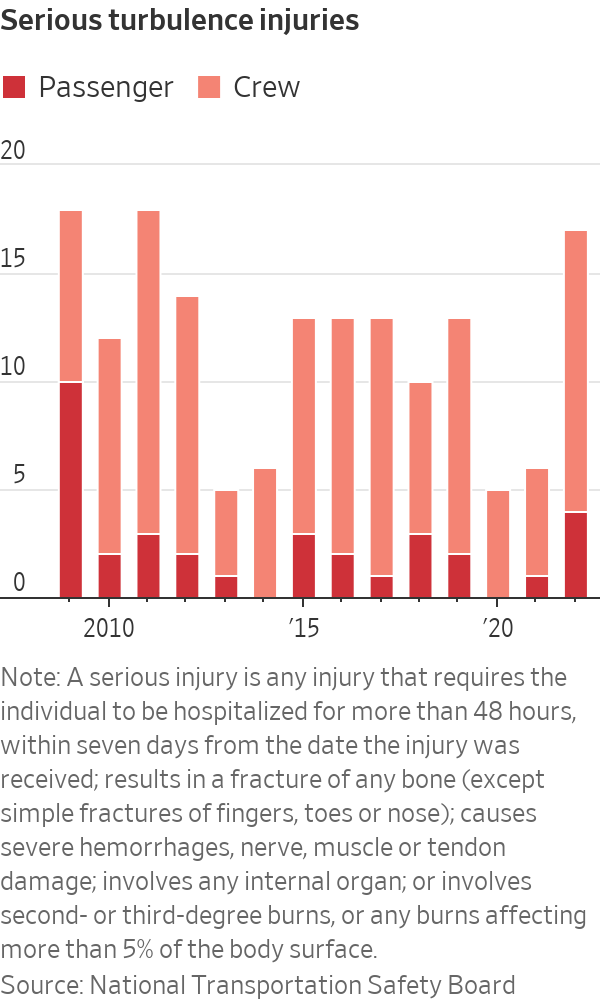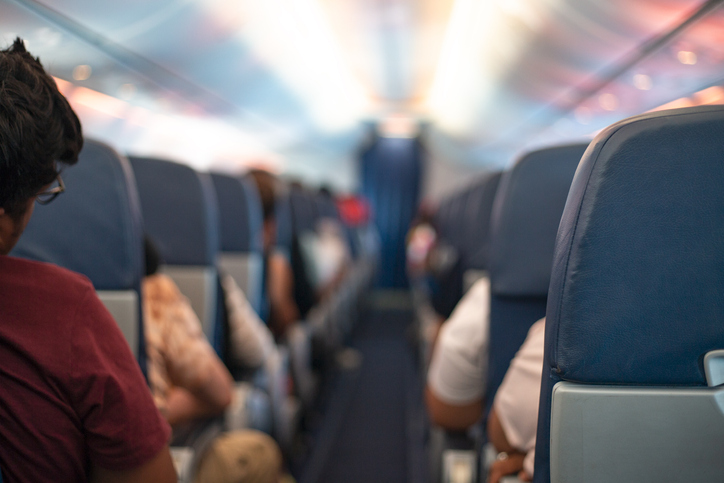Heavy Turbulence on Flights Is Likely to Get Worse
Meteorologists predict more bumpy flights as climate change makes hard-to-detect clear-air turbulence more common
Flights headed to Honolulu, Tampa, Fla., and Frankfurt in recent months hit turbulence so severe that some passengers and crew ended up in the hospital with injuries.
Actor Matthew McConaughey was a passenger on the Lufthansa flight to Germany. In a recent podcast interview with Kelly Ripa, he described seeing red wine suspended in midair before it crashed down.
“It was a hell of a scare,” Mr. McConaughey, who wasn’t hospitalised, said on the podcast. “A complete loss of control.”
Pilots and meteorologists say bumps are a normal part of flying. The Federal Aviation Administration is still investigating the Lufthansa flight. But meteorologists say climate change is distorting the jet stream, making a certain type of severe turbulence—called clear-air turbulence—more likely in the future.
Severe turbulence injuries are rare. Between 2009 and 2022, 163 people were seriously injured during turbulence, according to National Transportation Safety Board data. Flight attendants, who are more likely to be standing during flights, are most likely to get injured, the data show.
What the science says
Though technology that reports turbulence has vastly improved in recent decades, it can be tough to predict.
“You’re talking about a little pin drop in the atmosphere,” says Bill Duncan, head of aviation forecasting operations at the Weather Co., which supplies turbulence forecasts and weather insights to major airlines.
Turbulence happens when swirling air currents push against the wing of the plane, which then moves the wings up and down or the body of the plane from side to side, says Paul D. Williams, a professor of atmospheric science at the University of Reading in England.

Atmospheric pressure, changing wind direction, air around mountains and cold- or warm-weather fronts can cause turbulence, physicists say.
Turbulence caused by wind shear, meaning sudden changes in the speed and direction of wind, is called clear-air turbulence. It is called this because it occurs at higher altitudes in cloudless areas. Aircraft can change altitude suddenly, and pilots usually can’t detect this type of turbulence in advance.
Since 1979, the amount of wind shear in the jet stream has increased 15%, according to a study Dr. Williams co-wrote that was published in the science journal Nature in 2019. At higher altitudes where planes fly, climate change is altering temperature patterns, which creates more wind shear, he says.

Dr. Williams’s research predicts that the amount of clear-air turbulence in the atmosphere in the mid-Northern Hemisphere is expected to more than double over the next three to six decades.
Some of the more popular international flight routes from the U.S., such as New York-London and San Francisco-Tokyo, will experience more clear-air turbulence because they fly in the mid-Northern Hemisphere, he says.
Changes in procedure
Flight crews now use more specific language to address different levels of turbulence, says Dennis Tajer, a captain for American Airlines and spokesman for the Allied Pilots Association, a union. He began flying for commercial airlines about 30 years ago and says he encounters more clear-air turbulence now compared with early in his career.

American Airlines updated its flight manual in May 2022 to better define turbulence procedures for flight crews. The captain turns on the seat belt sign for all types of turbulence, but crews now take specific actions depending on the severity of the turbulence, he says.
During severe turbulence, flight attendants need to secure carts, place hot liquids in carts or on the floor and secure themselves as quickly as possible by sitting down in the nearest seat or on the floor.
American and United are among the airlines that give pilots access to software called SkyPath, which crowdsources turbulence reports from pilots’ iPads in real time.
SkyPath uses vibrations from the pilot’s iPad to measure turbulence and reports out to other nearby aircraft, providing advance warning of the conditions in real time, a United spokeswoman said in an email.
Tips for navigating turbulence
- Wear your seat belt. Staying strapped in is the best way to protect yourself if your flight hits unexpected turbulence, pilots and flight attendants say.
- Take precautions with children under 2. The FAA recommends passengers use an approved child-safety seat or device if traveling with a child under 2. Airlines don’t require children that young to have their own seats. Sara Nelson, the international president of the Association of Flight Attendants-CWA, and the union have renewed calls for all passengers to have their own seats.
- Secure your electronics and other hand-held devices. Anything that isn’t tied down can become a projectile, Ms. Nelson says.
- Remember the odds. Turbulence is scary because it is often unexpected and uncomfortable, says Todd Farchione, a clinical psychologist at Boston University’s Center for Anxiety and Related Disorders. Take a deep breath and realise you’re not truly in danger. Planes are built to withstand even heavy turbulence, pilots and physicists say.
 Copyright 2020, Dow Jones & Company, Inc. All Rights Reserved Worldwide. LEARN MORE
Copyright 2020, Dow Jones & Company, Inc. All Rights Reserved Worldwide. LEARN MORE
This stylish family home combines a classic palette and finishes with a flexible floorplan
Just 55 minutes from Sydney, make this your creative getaway located in the majestic Hawkesbury region.
As Paris makes its final preparations for the Olympic games, its residents are busy with their own—packing their suitcases, confirming their reservations, and getting out of town.
Worried about the hordes of crowds and overall chaos the Olympics could bring, Parisians are fleeing the city in droves and inundating resort cities around the country. Hotels and holiday rentals in some of France’s most popular vacation destinations—from the French Riviera in the south to the beaches of Normandy in the north—say they are expecting massive crowds this year in advance of the Olympics. The games will run from July 26-Aug. 1.
“It’s already a major holiday season for us, and beyond that, we have the Olympics,” says Stéphane Personeni, general manager of the Lily of the Valley hotel in Saint Tropez. “People began booking early this year.”
Personeni’s hotel typically has no issues filling its rooms each summer—by May of each year, the luxury hotel typically finds itself completely booked out for the months of July and August. But this year, the 53-room hotel began filling up for summer reservations in February.
“We told our regular guests that everything—hotels, apartments, villas—are going to be hard to find this summer,” Personeni says. His neighbours around Saint Tropez say they’re similarly booked up.
As of March, the online marketplace Gens de Confiance (“Trusted People”), saw a 50% increase in reservations from Parisians seeking vacation rentals outside the capital during the Olympics.
Already, August is a popular vacation time for the French. With a minimum of five weeks of vacation mandated by law, many decide to take the entire month off, renting out villas in beachside destinations for longer periods.
But beyond the typical August travel, the Olympics are having a real impact, says Bertille Marchal, a spokesperson for Gens de Confiance.
“We’ve seen nearly three times more reservations for the dates of the Olympics than the following two weeks,” Marchal says. “The increase is definitely linked to the Olympic Games.”

Getty Images
According to the site, the most sought-out vacation destinations are Morbihan and Loire-Atlantique, a seaside region in the northwest; le Var, a coastal area within the southeast of France along the Côte d’Azur; and the island of Corsica in the Mediterranean.
Meanwhile, the Olympics haven’t necessarily been a boon to foreign tourism in the country. Many tourists who might have otherwise come to France are avoiding it this year in favour of other European capitals. In Paris, demand for stays at high-end hotels has collapsed, with bookings down 50% in July compared to last year, according to UMIH Prestige, which represents hotels charging at least €800 ($865) a night for rooms.
Earlier this year, high-end restaurants and concierges said the Olympics might even be an opportunity to score a hard-get-seat at the city’s fine dining.
In the Occitanie region in southwest France, the overall number of reservations this summer hasn’t changed much from last year, says Vincent Gare, president of the regional tourism committee there.
“But looking further at the numbers, we do see an increase in the clientele coming from the Paris region,” Gare told Le Figaro, noting that the increase in reservations has fallen directly on the dates of the Olympic games.
Michel Barré, a retiree living in Paris’s Le Marais neighbourhood, is one of those opting for the beach rather than the opening ceremony. In January, he booked a stay in Normandy for two weeks.
“Even though it’s a major European capital, Paris is still a small city—it’s a massive effort to host all of these events,” Barré says. “The Olympics are going to be a mess.”
More than anything, he just wants some calm after an event-filled summer in Paris, which just before the Olympics experienced the drama of a snap election called by Macron.
“It’s been a hectic summer here,” he says.

AFP via Getty Images
Parisians—Barré included—feel that the city, by over-catering to its tourists, is driving out many residents.
Parts of the Seine—usually one of the most popular summertime hangout spots —have been closed off for weeks as the city installs bleachers and Olympics signage. In certain neighbourhoods, residents will need to scan a QR code with police to access their own apartments. And from the Olympics to Sept. 8, Paris is nearly doubling the price of transit tickets from €2.15 to €4 per ride.
The city’s clear willingness to capitalise on its tourists has motivated some residents to do the same. In March, the number of active Airbnb listings in Paris reached an all-time high as hosts rushed to list their apartments. Listings grew 40% from the same time last year, according to the company.
With their regular clients taking off, Parisian restaurants and merchants are complaining that business is down.
“Are there any Parisians left in Paris?” Alaine Fontaine, president of the restaurant industry association, told the radio station Franceinfo on Sunday. “For the last three weeks, there haven’t been any here.”
Still, for all the talk of those leaving, there are plenty who have decided to stick around.
Jay Swanson, an American expat and YouTuber, can’t imagine leaving during the Olympics—he secured his tickets to see ping pong and volleyball last year. He’s also less concerned about the crowds and road closures than others, having just put together a series of videos explaining how to navigate Paris during the games.
“It’s been 100 years since the Games came to Paris; when else will we get a chance to host the world like this?” Swanson says. “So many Parisians are leaving and tourism is down, so not only will it be quiet but the only people left will be here for a party.”
This stylish family home combines a classic palette and finishes with a flexible floorplan
Just 55 minutes from Sydney, make this your creative getaway located in the majestic Hawkesbury region.






















